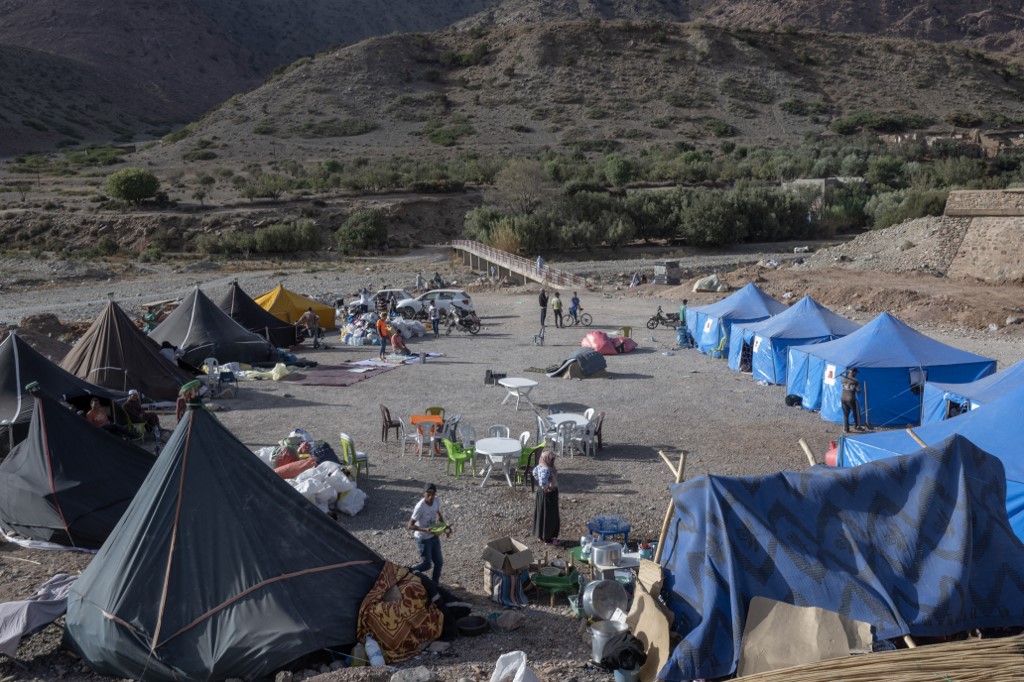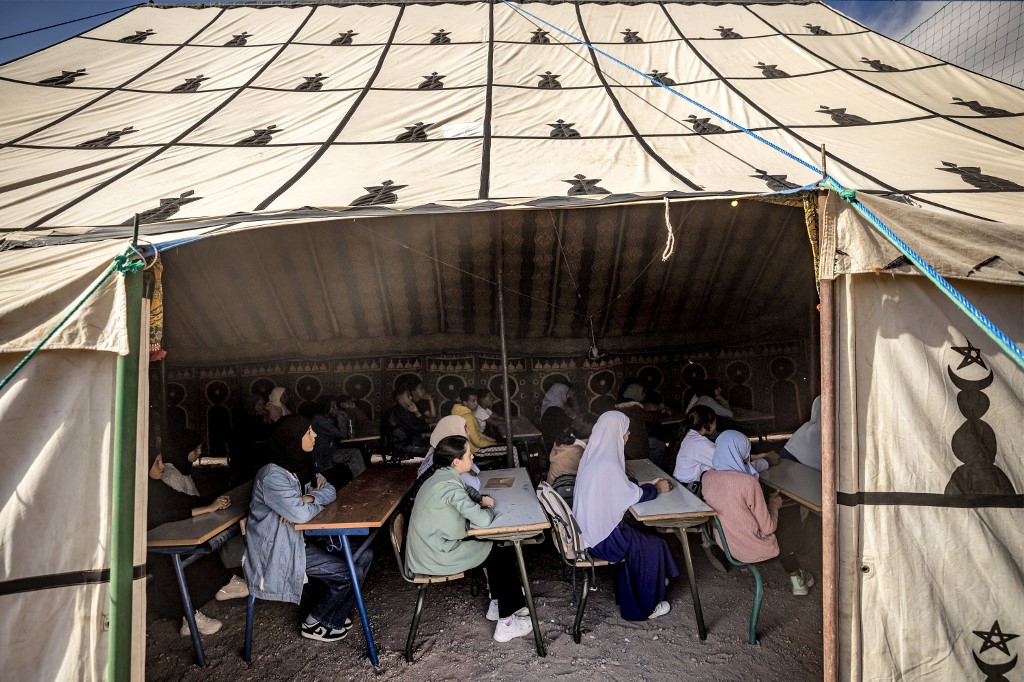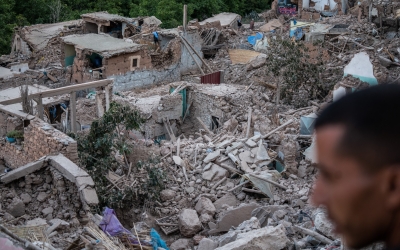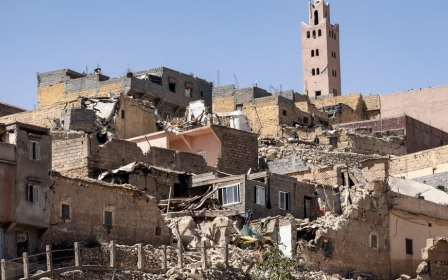Morocco earthquake: Victims say King Mohammed VI failed them

"Listen to me: King Mohammed VI has done nothing for us!"
Ahmed* has just burst into a busy street in earthquake-hit Amizmiz, and shares a despair, mixed with anger, with anyone willing to listen.
"Now, I no longer fear the government or anyone. I fear only Allah, that's all! We say 'praise be to God' because the government doesn't want to see anything."
Ahmed is a merchant. Originally from one of the main urban municipalities in the al-Haouz region, nestled at the foot of the High Atlas mountains in Morocco, he saw his life crumble when a magnitude seven earthquake shook the region on the night of 7-8 September 2023.
According to the interior ministry, this earthquake, the most significant in Morocco's history, killed 2,960 people.
New MEE newsletter: Jerusalem Dispatch
Sign up to get the latest insights and analysis on Israel-Palestine, alongside Turkey Unpacked and other MEE newsletters
"I had to carry my two little ones on my back to get out of the house. The ceiling fell on my wife, who was seriously injured in the arms and legs. She is in the hospital now," Ahmed tells Middle East Eye.
More than two months later, the memory of the catastrophe remains a raw wound for the mountain residents, who feel more isolated than ever.
After an initial wave of extensive national and international solidarity, which saw an influx of donations of clothing, food, medicines and sometimes shelters for the disaster victims, the movement has lost momentum, and the earthquake victims are helplessly witnessing the gradual normalisation of their misfortune.
Humanitarian urgency has given way to reconstruction projects, which require a long planning period. In this interim, the disaster victims have been housed in tents.
Distributed sometimes by the authorities, sometimes by NGOs, and sometimes assembled from scratch with whatever the residents had to hand, these electric-blue, white or yellow tents dot the mountains.
'We are about 50 families, and only 10 have received money so far'
- Amal, earthquake survivor
They spread out nearby and sometimes in the midst of the devastated douars (hamlets) in a more or less informal manner, transforming the landscapes of the High Atlas into a series of what some call "camps". Others call them "shantytowns".
"During the day, it's too hot inside, we suffocate, and at night it's too cold," says Amal*.
"It's very tough, especially for children and the elderly," she tells MEE. "My grandmother is 86 years old and lives like this with her kidney problems, can you imagine?"
Amal also lives with her husband and young daughter in a small tent pitched on the edge of the R203 road, connecting the battered provinces of Marrakech-Safi and Taroudant. She dreads the arrival of winter, which is already harsh in the mountainous heights.
'There is corruption here'
In the makeshift settlement of canvas and plastic that emerged in the aftermath of the earthquake, the luckier ones live in containers.
Some have already received the reconstruction aid money promised by the king: between 80,000 and 140,000 dirhams, approximately $8,000 to $14,000, depending on whether their house was damaged or destroyed.
"We are about 50 families, and only 10 have received money so far," says Amal.
"There is corruption here. They must know a sheikh or a moqqadem... No one tells us anything," she adds, referring to the auxiliaries of the Moroccan administration who manage daily affairs in the douars.
Beside her, a group of women nod in agreement. No one knows when the aid will come, and the wait is becoming increasingly difficult to bear.
"Everything is difficult, but our biggest problem now is food. It's hard to have enough to eat," says Amal.
Here, the 2,500 dirhams ($250) monthly allocation for each affected household has not yet arrived, she says. So, in the meantime, the women prepare food for the entire settlement in yet another tent, converted into a communal kitchen, where a few bags of flour and rice, brought from the nearest commune about 10km away, are stored.
This new closeness is not to everyone's liking, but people must deal with it. Some families live up to eight per tent, with children, parents and grandparents under the same canvas, sometimes uncles and aunts too.
During the day, men go out to the market or the cafe, children attend their lessons in the new school set up under a big top, and women try to manage these new precarious households, which requires a lot of effort.
Money is no longer coming in because almost all businesses are now at a standstill, so everyone relies on resourcefulness and occasional and unpredictable assistance.
'I don't want aid, I want business'
Across the douars and valleys, the story repeats itself.
The economy has ground to a halt in the Armed douar, near the tourist commune of Imlil, the starting point for hikers wishing to climb Toubkal, the highest mountain in Morocco, which at 4,167 metres above sea level attracts many Moroccan and foreign tourists.
At 32, Lahcen, who used to work in a thriving cooperative owned by his father, making products based on argan oil, has almost ceased all activities.
"Before, I worked in Imlil with three people," he says. "We had two shops, everything was going well. But since the earthquake, there's no more work.
"It's tough for everyone. Not many people come any more, people don't have money, and many tourists go elsewhere, to Essaouira, Agadir or Marrakech, in the big cities," he tells MEE.
"The people who come now just want to give help, but I don't like that. I don't want aid. I want business, it's much better," he says.
Lahcen's house was relatively spared by the earthquake, except for a few cracks in the concrete of the walls and ceiling.
But a few metres below, his nephew Hamza's house completely collapsed. All that remains are stairs leading to nowhere and unstable debris, from which children must be kept away.
At 16, Hamza moved in with his uncle and earns some money by working on small construction sites, clearing debris from other collapsed houses.
Lahcen, on the other hand, turned to Europe, to where he now manages to send some goods to make ends meet, while waiting for the local market to recover.
Marginalised areas
In the High Atlas, mountain villages, which were already neglected by the central government before the earthquake, have suffered the heavy consequences of their geographical and political isolation.
With one of the highest rates of multidimensional poverty in the kingdom (18.5 percent for all affected regions, compared with 8.2 percent nationally), the area, home to a predominantly Amazigh population, is expected to take years to recover from the disaster.
While the Moroccan government hopes to rehouse everyone within a year, many architects find it difficult to envision reconstruction within five years.
Although the state has announced a massive aid plan, the extent of the unexpected destruction in an area believed to be relatively immune to earthquakes has caught all administrations off guard.
While the latest report from the High Planning Commission lists 169 affected municipalities in four regions, home to more than 2.6 million people, a vast reconstruction project now looms.
At least 59,674 homes are damaged or destroyed, and architects throughout the kingdom are being mobilised.
But even before the first stones are laid, a process of assessments, authorisations and funding must be undertaken, which takes time.
Meanwhile, the patience of the disaster victims wears thin, the burden becomes heavier, and anger rises.
**For security reasons, their first names have been changed.
This article was originally published in French.
Middle East Eye delivers independent and unrivalled coverage and analysis of the Middle East, North Africa and beyond. To learn more about republishing this content and the associated fees, please fill out this form. More about MEE can be found here.








